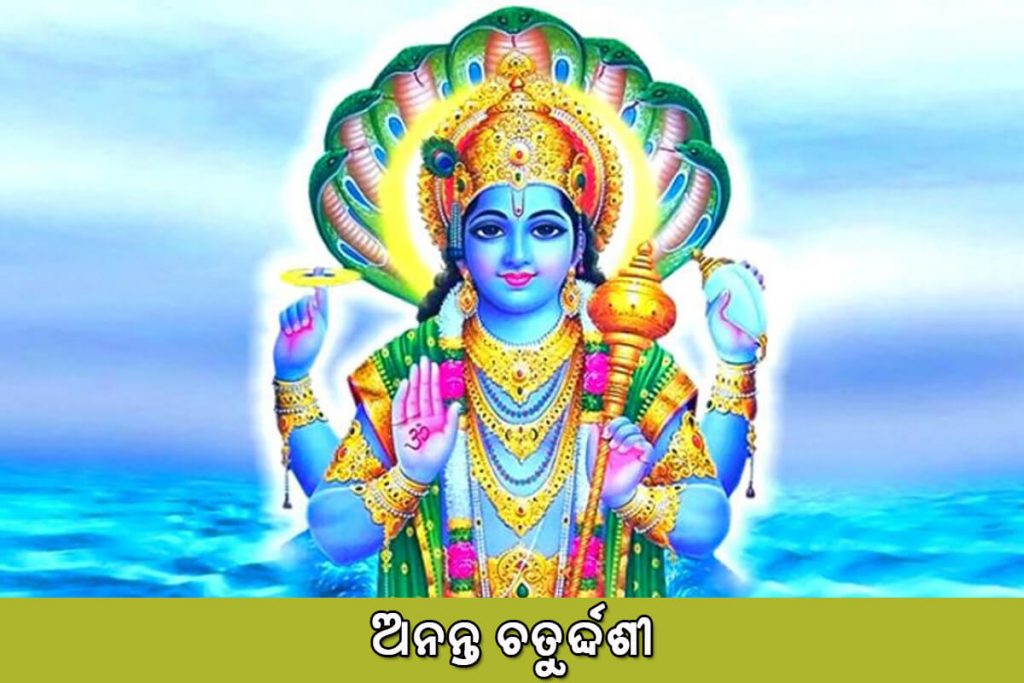Eternal Fourteenth Bhadrava Shukla is celebrated on the fourteenth day. Born of Mahamuni Kashyap and Daksha-daughter Kadru, Ananta is praised in the Puranas as the last, Basuki and Shonas. According to the Harivansh Purana, Anantadev abandoned his mother and took an air vow. Eternal pilgrimage to the pilgrimage site was auspicious for many pilgrims. Enjoyed by the austere asceticism, his grandfather Brahma blessed him with fear and ordered him to occupy the troubled earth and stabilize the earth. Ever since then, Eternal has been holding the earth in his head for worship. Earthquakes, etc., are believed to occur when Eternal moves his head. This eternity is described everywhere as the bed of Srihari Yoganidra lying in the sea of milk by lying on the horizon. In the Tretya period, Sumitra Nandan Laxman was said to be the incarnation of Sheshnag, while in Dwapar, Balabhadra Balarama was known as Ananta. Bhadrava Shukla Chaturdashi is the date of the vow of the eternal deity. Both men and women observe this eternity on the fourteenth day of Eternal, wishing happiness and happiness. Once observed, the vows are observed with great devotion for up to 18 years. On this day, the idol of Shalgram stone or metal is worshiped by bathing in the morning and wearing new clothes. The statue of the eternal deity must be square. His body and clothes are white. He is armed with a variety of gems, including armor-piercing conch shells and lotuses. People who wish to observe the vows are worshiped in various treatments by placing a Shalgram or metal idol in a Padma Mandal or Bhadra Mandal while wearing a bath and a deity. The octagonal snake is also worshiped at this time. The new vow is loaded after the old vow is opened and immersed in raw milk. The men hold the vow at the base of the right hand and the woman at the base of the left hand. This vow is very sacred. There is also advice from this eternity for religious life without sin. In the future Puranas, the greatness of this Brahma is especially mentioned in the news of Krishna and Yudhisthira. Asked by Yudhisthira whether the vows were to be observed for the benefit of the quadrangular fruits, Lord Krishna advised him to observe this eternal vow. According to the vows, there was a Brahmin named Simanta in a prominent tribe in the Satyayuga. His wife was Bhrigu Kanya Diksha. From their union, a girl named Sushila was born. Sumantha married Karkasha, the daughter of a Brahmin priest, after she died of diarrhea on a daily basis. Naturally, Mukhara and Kalihudi Karksha could not bear the girl. As she got older, Sushila got married to a Brahmin youth named Kundinya. Determined not to pay the dowry to the son-in-law, Karksha fled to the orphanage with all the belongings in the house. But Sumanth bid farewell to his daughter-in-law by giving him a dowry of rice husks. On the way, a woman was seen wearing a red robe on a riverbank. Sushila learned from them and made a vow herself. As a result, Kundinya’s house was filled with treasures and happiness. One day the property in the hands of Kundinya Karksha was destroyed. Kundinya regained his heart by performing an eternal vow. Even uneducated students, archers, hard-working bulls, elephants, donkeys, and ponds are described in this title as being freed from the curse by observing the eternal vows. Therefore, devotees perform this ritual with devotion. In India, archeological research on the worship of Ananta dates back to the first century BC. Anant Basudev’s temple is located on the banks of the Bindusagara in Bhubaneswar, and is also worshiped in the temple. In the Eternal Fourteenth, special rituals are performed here.
Comments
comments
